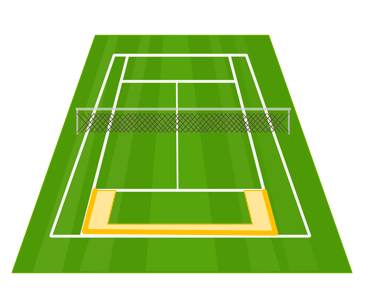AO Leaderboard— Line Hitting
29 Oct 2016This week continues the rollout of a collection of new statistics describing the quality of shots in tennis. Last week began with a look at groundstroke speeds, focusing on the backhand. This week we turn to the accuracy of groundstrokes and look specifically at how frequently shots land close to the line.
Whether a ball lands close to a line is obviously a subjective call. In the summaries that follow, I will use 3 ball lengths (approximately 21 cm) as “close”. As in the previous post, the stats that follows come from Tennis Australia’s GIG and are based on matches played at the 2014 to 2016 Australian Open.

When we consider all groundstroke shots, shots very close to the line turn out to be fairly infrequent. ATP players fall somewhere between 2 and 7%, which suggests that the majority of the game is played more in the center of the court than we might have imagined.
Since only the most aggressive players and players who want to keep points short (like big server John Isner) will go for the lines with high frequency, it would be better to measure the accuracy of player shots for the subset of shots that are aiming for a line. Now, we don’t know what players were intending to do on any given shot. But, if the ball is closer to the lines than the center of the court, we can infer that they were aiming for a line. It is likely that a good portion of these shots will be shots that land within 1m of a line (whether the sideline or baseline): the region that is highlighted in gold in the court diagram above. The point values to the right of the plot show the percentage of shots landing close to the line within this subset.
We find John Isner still at the very top with 27, reflecting his quick and aggressive stile of play. Three other big servers with a similar style as Isner, Sam Querrey, Sam Groth and Marin Cilic, also are close to the top and all have frequencies of 21% or greater. The most highly ranked players were with the 15 to 20% range, the exceptions being Andy Murray and David Ferrer with frequencies of 13%. The rankings we see at the Australian Open suggest that players with groundstrokes that are closer to the line on average are the more offensive, attacking players on the tour.
When we look at the trends in line-hitting among WTA players, we see similar patterns as the men. Fewer players earn percentages of 20% or more, even when considering only those shots within 1m of the nearest line. But those players that do are also known for an aggressive style of play— Sabine Lisicki, Madison Keys, and Monica Puig.
Unlike the men, fewer players are clustered between 15% and 20%. Instead, more players are within the 10% to 15% group. Surprisingly, Serena Williams, who is known for her big hitting, is toward the bottom of the group in terms of shots landing close to the line. Suggesting that she may take her time for big shots more than we appreciate. Others in this range of the rankings are more expected and known for a defensive style of play, like Aga Radwanska and Carla Suarez Navarro.Radwanska will face Angelique Kerber this weekend in the semifinal of the WTA Tour Finals. We can expect Kerber to slightly edge out Radwanska on the frequency of line-hitting shots.
After last week’s post, reader Amir Bachar raised the question of ball type and whether men and women at the Australian Open use a different type that could explain any differences in shot characteristics. Ball type can definitely have an impact on ball pace and spin. From 2014 to 2016, the Australian Open has used a Wilson Type 2 ball (under the ITF classification scheme) and the same ball has been used for men’s and women’s events.
The major message from this review of accuracy stats is how infrequent line-hitting actually is when we think of all groundstroke shots and not just the shots that end a point. So the next time we see fans gasp and get out of their seats to cheer for a shot that just catches the line, we will know that they have truly seen something special.
If you liked this story, share it with your followers or follow this site @StatsOnTheT on Twitter.
